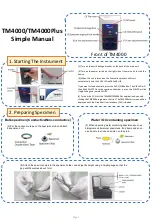
Rev. B
MultiMode SPM Instruction Manual
147
Chapter 9 Scanning Tunneling
Microscopy (STM)
STM relies on “tunneling current” between the probe and the sample to sense the topography of the
sample. The STM probe, a sharp metal tip (in the best case, atomically sharp), is positioned a few
atomic diameters above a conducting sample which is electrically biased with respect to the tip. At
a distance under 1 nanometer (0.001µm), a tunneling current will
fl
ow from sample to tip. In
operation, the bias voltages typically range from 10 to 1000mV while the tunneling currents vary
from 0.2 to 10nA. The tunneling current changes exponentially with the tip-sample separation,
typically decreasing by a factor of two as the separation is increased 0.2nm. The exponential
relationship between the tip separation and the tunneling current makes the tunneling current an
excellent parameter for sensing the tip-to-sample separation. In essence, a reproduction of the
sample surface is produced by scanning the tip over the sample surface and sensing the tunneling
current.
The following sections are included in this chapter:
•
•
•
•
•
•
•
•
•
•
•
•
Head and Microscope-related Problems:
STM
















































